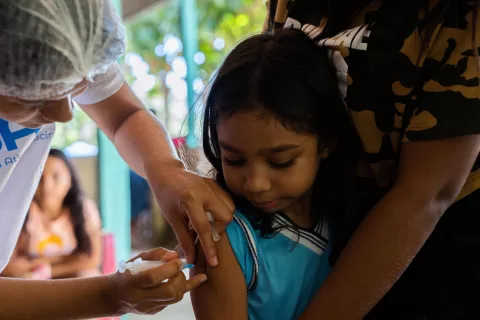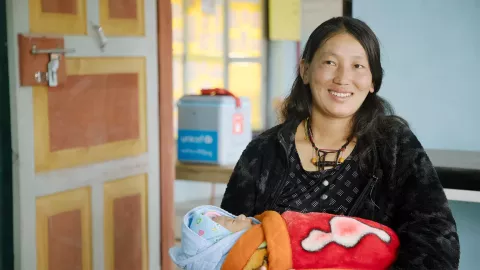Georgia faces its lead problem head on
UNICEF is supporting the country’s efforts to tackle worryingly high blood lead levels in children.

KVATSIKHE, Georgia – Barbare, 4, has a pleased look on her face as she struts around the living room wearing her pink fluffy bunny slippers. But it’s clear she thinks there’s something missing from her outfit. Can she put on some children’s lipstick and nail polish? Her mother’s response is unequivocal: “no”.
Giuli has good reason to be cautious about her daughter using makeup – or any product that could contain lead. Barbare was part of a 2018 study into blood lead levels in children in Georgia that found 41 per cent of children had lead levels greater than or equal to 5 micrograms per decilitre (µg/dL). While there is no known level of lead exposure that is considered safe for human beings, Barbare’s reading of 13.2 micrograms μg/dL was well above the baseline at which the World Health Organization recommends initiating public health action.
“I was completely shocked,” Giuli says.

Lead exposure can have a devastating impact on a child’s health, including growth and developmental delays as well as learning disabilities. Exposure to high lead levels among pregnant women can lead to miscarriage, stillbirth or premature birth. After anecdotal evidence suggested high blood lead levels among Georgian children, UNICEF Georgia designed and conducted, along with Georgia’s National Statistics Office, a nationally representative survey based on the collection of around 1,570 blood samples from children aged 2-7 years.
The blood samples were sent to the Italian National Institute of Health in Rome and tested for toxic metals. The results were alarming: a quarter of children had blood lead levels between 5 - 10 μg/dL, and 16 per cent had levels of 10 µg/dL or more.
Giuli says that Barbare started talking quite late and that her son was born with cerebral palsy. “I was scared when I was told that it hinders development,” she says.
Nine-year-old Nutsa was also a participant in the study, and her lead levels were even more shocking than Barbare’s: 37.2 μg/dL. Nutsa lives in Georgia’s Adjara region, where around 85 per cent of children had lead levels higher sthan 5 μg/dL, and half had concentrations of 10 μg/dL or more.

Armed with the information gathered from the tests, the Government, with UNICEF support, has embarked on a multiyear plan to identify and control the major sources of lead exposure in the country, and to develop short-, medium- and long-term measures to manage the problem.
Dr. Irma Chikvaidze, a pediatrician at a clinic in Batumi, the capital of the Adjara region, says that little was known about the problem when the results first came out.
“We had some theoretical knowledge, that was all,” she says, adding that the findings may shed light on the high number of unresolved cases of slow childhood development she has seen.
As part of the national strategy, Dr. Chikvaidze and other medical personnel were provided with additional training to hone their understanding of the problem, including how to identify and respond to potential cases, and to encourage knowledge sharing among colleagues.
“Children with developmental issues are now being referred for lead tests,” Dr. Chikvaidze says. “Everyone I know [has] wanted to get tested.”
“A moral responsibility”
Georgia doesn’t currently have a public laboratory for the type of testing necessary, instead having to test blood samples overseas. And at around Gel 120 (around US$40) each, the tests have been beyond the reach of many Georgians, Dr. Chikvaidze says.
UNICEF is therefore working with the National Centre for Disease Control (NCDC) to establish its own laboratory and is also supporting the government in designing and establishing an environmental health surveillance system to collect data on pollution, human exposure to pollutants and the prevalence of related diseases.
“We felt there was a moral responsibility to continue [to address this] and this was nurtured by the very strong partnership we have with the NCDC,” says Ghassan Khalil, UNICEF Representative in Georgia. Khalil adds that UNICEF has been working closely with partners after receiving initial funding from the Estonian Embassy in the Georgia capital Tbilisi for the search for potential lead sources.
The NCDC has developed a 10-year strategy for tackling the country’s lead problem, and the Georgian Government has already begun rolling out new regulations on toys, is enforcing stricter construction standards for kindergartens, and is providing full governmental funding for lead testing for children referred by a doctor, among other measures.
Eventually, the NCDC is hoping to develop the capacity to test lead levels inside private homes, says Dr. Lela Sturua, head of non-communicable diseases at the NCDC.
In the meantime, the advice to families is to encourage handwashing, wash children’s toys, be careful where children are playing and be cautious about potentially overlooked sources of lead contamination, such as certain spices.

Since receiving the results of the study, Barbare and Nutsa are among those who have been provided with comprehensive medical assistance for no charge. As a result, Barbare’s blood lead levels have decreased to 7.9 μg/dL, while Nutsa’s have more than halved.
“I think we were lucky to be part of this survey because now we are receiving special care,” says Giuli. She says other mothers at her daughter’s kindergarten now come to her for advice on how to protect their children. But she adds that it’s obvious the problems facing their village aren’t yet behind them.
“So far, out of about 40 families in the village, only one child has been tested. I think there will be more cases.”
Around 1 in 3 children – up to 800 million globally – have blood lead levels at or above 5 micrograms per deciliter (µg/dL), according to a report by UNICEF and Pure Earth. The full report, ‘The Toxic Truth: Children’s exposure to lead pollution undermines a generation of potential’, was launched on 30 July, 2020, and is available here.



